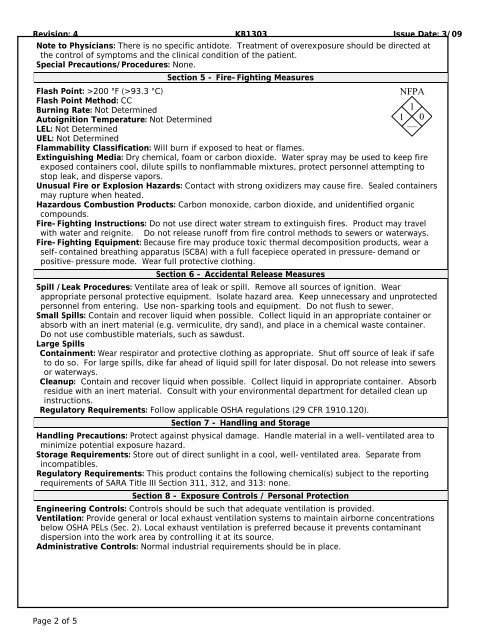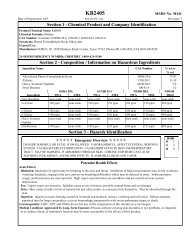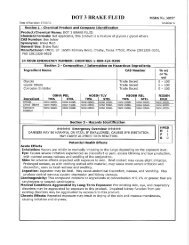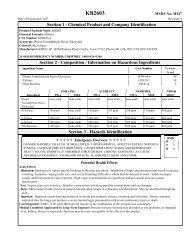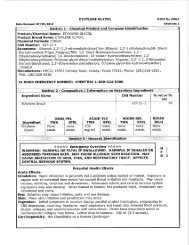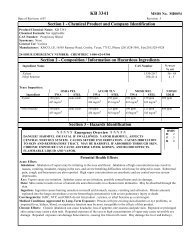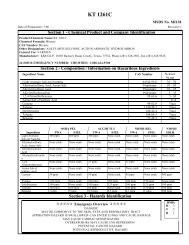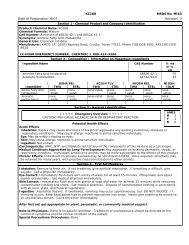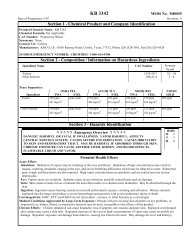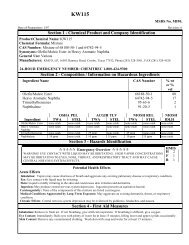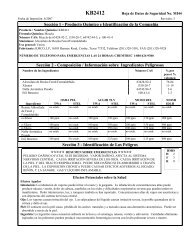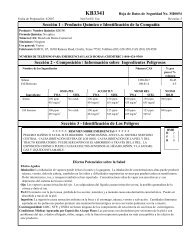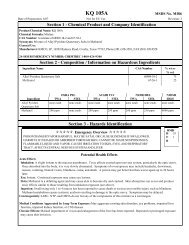KB1303 NOT FOR EXPORT TO THE EU MSDS No. MI30 ... - KMCO
KB1303 NOT FOR EXPORT TO THE EU MSDS No. MI30 ... - KMCO
KB1303 NOT FOR EXPORT TO THE EU MSDS No. MI30 ... - KMCO
Create successful ePaper yourself
Turn your PDF publications into a flip-book with our unique Google optimized e-Paper software.
Revision: 4 <strong>KB1303</strong> Issue Date: 3/09<br />
<strong>No</strong>te to Physicians: There is no specific antidote. Treatment of overexposure should be directed at<br />
the control of symptoms and the clinical condition of the patient.<br />
Special Precautions/Procedures: <strong>No</strong>ne.<br />
Section 5 - Fire-Fighting Measures<br />
Flash Point: >200 °F (>93.3 °C)<br />
NFPA<br />
Flash Point Method: CC<br />
Burning Rate: <strong>No</strong>t Determined<br />
1<br />
Autoignition Temperature: <strong>No</strong>t Determined<br />
1 0<br />
LEL: <strong>No</strong>t Determined<br />
—<br />
UEL: <strong>No</strong>t Determined<br />
Flammability Classification: Will burn if exposed to heat or flames.<br />
Extinguishing Media: Dry chemical, foam or carbon dioxide. Water spray may be used to keep fire<br />
exposed containers cool, dilute spills to nonflammable mixtures, protect personnel attempting to<br />
stop leak, and disperse vapors.<br />
Unusual Fire or Explosion Hazards: Contact with strong oxidizers may cause fire. Sealed containers<br />
may rupture when heated.<br />
Hazardous Combustion Products: Carbon monoxide, carbon dioxide, and unidentified organic<br />
compounds.<br />
Fire-Fighting Instructions: Do not use direct water stream to extinguish fires. Product may travel<br />
with water and reignite. Do not release runoff from fire control methods to sewers or waterways.<br />
Fire-Fighting Equipment: Because fire may produce toxic thermal decomposition products, wear a<br />
self-contained breathing apparatus (SCBA) with a full facepiece operated in pressure-demand or<br />
positive-pressure mode. Wear full protective clothing.<br />
Section 6 - Accidental Release Measures<br />
Spill /Leak Procedures: Ventilate area of leak or spill. Remove all sources of ignition. Wear<br />
appropriate personal protective equipment. Isolate hazard area. Keep unnecessary and unprotected<br />
personnel from entering. Use non-sparking tools and equipment. Do not flush to sewer.<br />
Small Spills: Contain and recover liquid when possible. Collect liquid in an appropriate container or<br />
absorb with an inert material (e.g. vermiculite, dry sand), and place in a chemical waste container.<br />
Do not use combustible materials, such as sawdust.<br />
Large Spills<br />
Containment: Wear respirator and protective clothing as appropriate. Shut off source of leak if safe<br />
to do so. For large spills, dike far ahead of liquid spill for later disposal. Do not release into sewers<br />
or waterways.<br />
Cleanup: Contain and recover liquid when possible. Collect liquid in appropriate container. Absorb<br />
residue with an inert material. Consult with your environmental department for detailed clean up<br />
instructions.<br />
Regulatory Requirements: Follow applicable OSHA regulations (29 CFR 1910.120).<br />
Section 7 - Handling and Storage<br />
Handling Precautions: Protect against physical damage. Handle material in a well-ventilated area to<br />
minimize potential exposure hazard.<br />
Storage Requirements: Store out of direct sunlight in a cool, well-ventilated area. Separate from<br />
incompatibles.<br />
Regulatory Requirements: This product contains the following chemical(s) subject to the reporting<br />
requirements of SARA Title III Section 311, 312, and 313: none.<br />
Section 8 - Exposure Controls / Personal Protection<br />
Engineering Controls: Controls should be such that adequate ventilation is provided.<br />
Ventilation: Provide general or local exhaust ventilation systems to maintain airborne concentrations<br />
below OSHA PELs (Sec. 2). Local exhaust ventilation is preferred because it prevents contaminant<br />
dispersion into the work area by controlling it at its source.<br />
Administrative Controls: <strong>No</strong>rmal industrial requirements should be in place.<br />
Page 2 of 5


